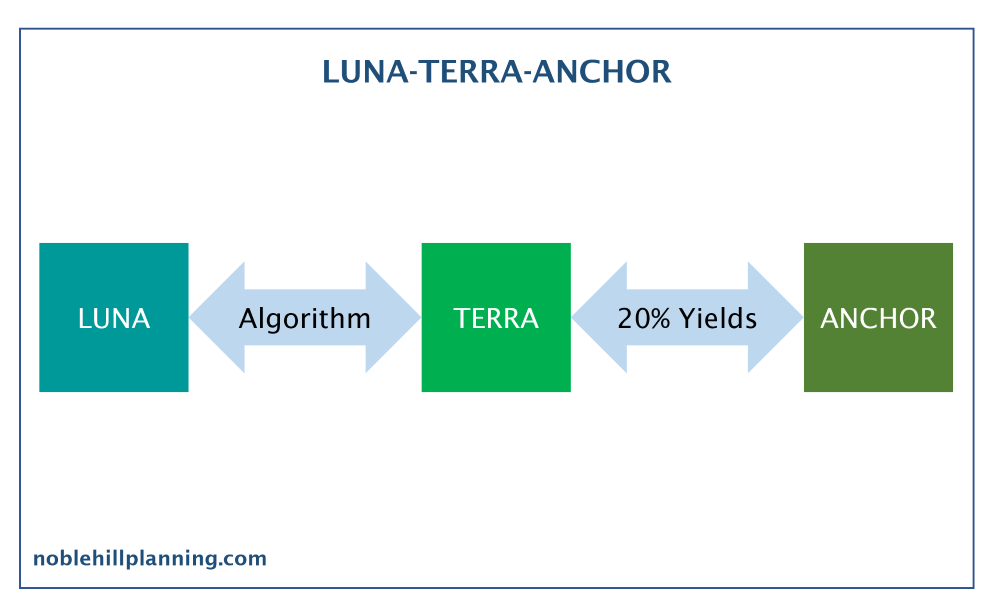In case you have been living under a rock, I’ll be the first to tell you that the markets are in turmoil. Stocks have sold off significantly this year, with the S&P 500 down over 15% year-to-date. Bonds haven’t done much better, with the Vanguard Total Bond Market ETF down almost 10% so far this year.
And just like for Dorothy and her companions in the Wizard of Oz, there are hazards all around us. In fact, one cryptocurrency called Luna promptly went to zero the other day and destroyed between $30 and $60 billion of paper value including the entire life savings of a few people.

How does this work again?
One interesting thing about Luna’s crash to zero was that pretty much nobody knew how Luna worked. Luna was one part of a complex system that included another cryptocurrency (Terra or UST) and a lending platform (Anchor).
Luna and Terra were designed to work together. Terra’s purpose was to maintain a fixed value of $1 while Luna’s value was allowed to float based on supply and demand in the market. Terra is known in the marketplace as a “stablecoin” in that it has a stable price.
Stablecoins like Terra are an important component of the cryptocurrency ecosystem as they help facilitate trades in other major digital assets such as bitcoin or ethereum. It’s much like the role the US Dollar plays in financial markets. For example, if you want to buy a share of Apple or Microsoft, you pay in dollars, not in bags of gold or wheat or baseball cards or whatever. And if you want to buy bitcoin, it’s very common nowadays to pay with stablecoin called Tether.1
One thing to keep in mind is that most stablecoins attain stability by holding (or claiming to hold) enough dollars in reserve. So if 50 million units of the stablecoin are in the marketplace, then the stablecoin sponsors will hold $50 million in a bank account.
However, the sponsors of Terra decided to go in a completely different direction. Instead of holding reserves to support Terra, they had a, uh… computer program?!2 In a nutshell, an algorithm linked Terra and Luna together. The algorithm helped determine how much of each cryptocurrency to create or destroy to maintain Terra’s stability. The hope was that holders of Terra would be able to “cash out” into Luna if there were ever any problems. That didn’t work out so well.
On top of this convoluted relationship, you can add Anchor, the online lending platform I mentioned earlier. Anchor offered yields of around 20% to anyone who deposited their Terra holdings. So if you bought some Terra and then gave it to Anchor, they would pay you 20%. Too good to be true? I think so. It turns out that 85% of the Terra in circulation was on loan to Anchor. People were buying Terra to chase those 20% yields.
A delicate system
In the end, the sell off in cryptocurrency markets over the past few weeks exposed the whole system. Holders of Terra and Luna got nervous and started selling and as the pressure increased… the algorithm faltered. Luna went from over $80 to zero and Terra dropped to about 20 cents on the dollar.
My guess is that most of the people buying Luna or Terra had no idea how any of this worked. And I can’t deny that greed likely played a large role in people investing in these assets. But in the end it’s a good reminder to be careful when choosing investments. Warren Buffett has always talked about investing in things that you can understand. And most people can understand how a business or a bond works. But an algorithmic stablecoin? Not likely. If you don’t understand how something works, don’t be afraid to take a pass and move on to something else. It could make all the difference in your financial future.
1 Tether also recently lost it’s $1 peg and has a host of problems that we won’t get into here, but feel to read more about them here, here, or here.
2 To be fair, there was also a backstop of bitcoin on the Luna side of things. Not sure a bitcoin backstop makes much sense either, but what do I know.

